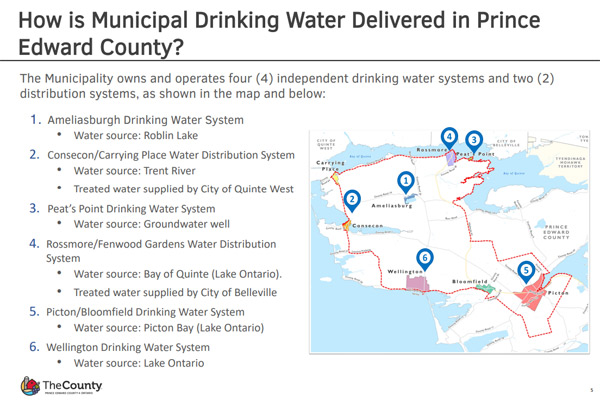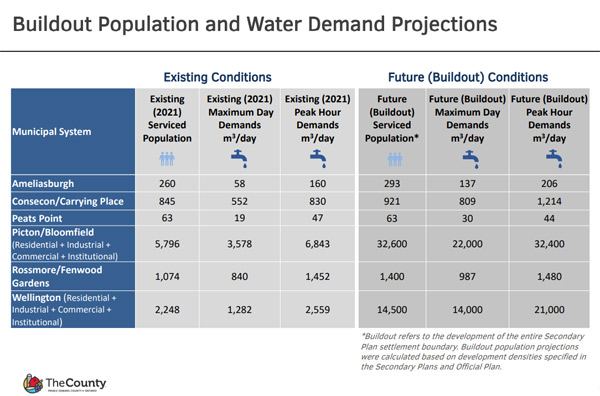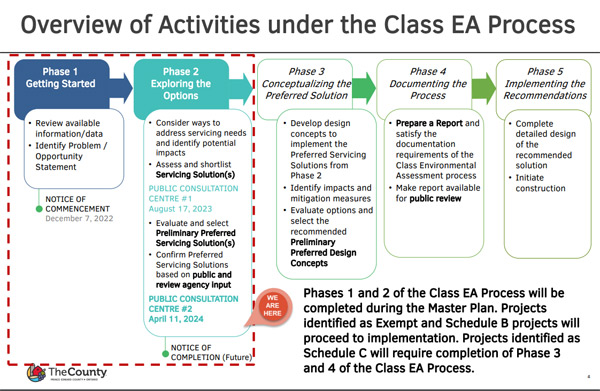Short-listed options for water master plan pegged at more than $100 million
Administrator | Apr 13, 2024 | Comments 3

The Wellington and District Community Centre saw a reasonable turnout on a rainy night at the next stage in the regional water supply servicing master plan where the preliminary preferred water supply servicing alternatives were revealed to the public. – Sharon Harrison photos
By Sharon Harrison
In short, if the preliminary preferred options get the go ahead, Wellington will get a new water treatment plant and there will be a big pipe to deliver water to from Wellington to Bloomfield/Picton.
While the proposed massive upgrades are years away (implementation expected in 5-10 years), the estimated costs are staggering.
The capital costs for a new Wellington regional water treatment plant are pegged at $40 million; a new Wellington raw water intake, estimated capital cost of $15 million, and a new transmission water main connecting Wellington and Picton, estimated capital cost $50 million – for a total of $105 million.
While it’s still early days to know how exactly expansion plans would be funded, a study has noted the new regional water treatment plan and raw water intake would be funded by both Wellington area and Picton area development charges or connection charges, with the new transmission water main and booster pumping station to be funded only by Picton area development charges, or connection charges.
Next steps will determine funding and allocation of costs to existing users versus new growth, and will include detailed design and construction costs. It is noted that if the County builds the new infrastructure now (within the next 10 years), approximately 75 per cent of the total costs can be paid for by developers of the new homes.
While Prince Edward County is surrounded by fresh water, and fortunate to find itself on the doorstep of the largest freshwater lake system in the world, supplying and servicing water, including drinking water, to not only the existing community, but an expanding one for the long-term, has been on the County’s radar for a few years.
Having presented a long-list of options at a crowded public meeting in Bloomfield last August, where public feedback was sought (see story here: https://www.countylive.ca/residents-flood-town-hall-thirsty-for-information-on-water-supply-plans/), the public was invited to a second information meeting Thursday evening for an update.
The Wellington and District Community Centre saw a reasonable turnout on a rainy night at the next stage in the regional water supply servicing master plan where the preliminary preferred water supply servicing alternatives were revealed to the public, many of whom seemed anxious to know what was happening to their water.
The master plan study is being undertaken by the municipality to identify the best approach for replacing aging infrastructure, supporting future growth, and addressing threats to source water protection.
 The results of this stage of the study were presented in a series of information boards at the open-house style meeting, but did not include a presentation. While the public was left to read and interpret the 36 display boards, an abundance of County staff, as well as representatives from the consulting firm who undertook the study, were on hand to discuss the information, answer to questions and explain what it all meant.
The results of this stage of the study were presented in a series of information boards at the open-house style meeting, but did not include a presentation. While the public was left to read and interpret the 36 display boards, an abundance of County staff, as well as representatives from the consulting firm who undertook the study, were on hand to discuss the information, answer to questions and explain what it all meant.
Currently in the County, the drinking water system is provided by four independent municipally-owned drinking water systems, and two distribution systems.
 The four systems include the Ameliasburgh drinking water system (sourced from Roblin Lake), Consecon/Carrying Place water distribution system (sourced from Trent River and treated and supplied by City of Quinte West), Peat’s Point drinking water system (sourced via groundwater well), and Picton/Bloomfield drinking water system (sourced from Picton Bay).
The four systems include the Ameliasburgh drinking water system (sourced from Roblin Lake), Consecon/Carrying Place water distribution system (sourced from Trent River and treated and supplied by City of Quinte West), Peat’s Point drinking water system (sourced via groundwater well), and Picton/Bloomfield drinking water system (sourced from Picton Bay).
The two distribution systems are Rossmore/Fenwood Gardens water distribution system (sourced from the Bay of Quinte, treated and supplied by City of Belleville), and Wellington drinking water system (sourced from Lake Ontario).
The study looked at the build-out population and water demand projections for each of these systems, and in particular noted the most significant growth in the largest centres of Wellington and Picton/Bloomfield.
For example, the existing (2021) serviced population for Wellington shows 2,248 users (residential, commercial, industrial and institutional) versus future (build-out) serviced population predictions of 14,500.
For Picton/Bloomfield, the existing (2021) serviced population is 5,796 (residential, commercial, industrial and institutional), with a future (build-out) serviced population of 32,600 projected.
Below are the short-listed options for the six areas:
SHORT-LISTED OPTIONS – PICTON/BLOOMFIELD
Favoured option: Obtain all water from new Wellington regional water treatment plant.
Three short-listed alternative servicing strategies presented for the Picton/Bloomfield drinking water system include providing a new water system in Picton, expand, upgrade, retrofit existing water system, and obtain water from another municipal source (i.e. Wellington).
The study noted exploring alternative water sources for Picton/Bloomfield and reduce or eliminate major concerns with source water protection, and maximizing synergies with on-going planning studies.
Of concern is a current system that cannot support immediate and long-term needs of service area, complex and costly current operational practices due to aging infrastructure, limited footprint available for plant expansion, historical major concerns with vulnerability and potential for contamination of Picton Bay and source water, and the Picton water treatment plant will need to be completely replaced by 2032.
The preliminary preferred alternative is to obtain all water from new Wellington regional water treatment plant, with the transmission main route from Wellington to Bloomfield and Picton routed primarily to be along the Millennium Trail.
SHORT-LISTED OPTIONS – WELLINGTON
Favoured option: Provide a new water system.
Seven short-listed alternative servicing strategies were presented for Wellington, where it was noted that Wellington’s water servicing strategies are handled differently to other areas of the County as it comes under the Wellington Master Servicing Plan completed in 2021.
Assessment of water servicing strategies for Wellington were evaluated in that plan and it is noted that council approved a capital budget of $23.6 million in 2022 for the replacement of the Wellington water treatment plant.
The seven options considered for Wellington are: do nothing, limit growth, water conservation measures, expand, upgrade, retrofit existing water system, provide a new water system, obtain potable water from other water supply systems and new groundwater sources and treatment facility(ies).
The preliminary preferred alternative is to provide a new water system, that is build a new water treatment plant at the existing site in Wellington (which it is noted has sufficient available area to accommodate a new plant) with more capacity, and decommission the existing water treatment plant.
Capital costs for this option are described as moderate, at an approximate cost of $37.1 million, with a life-cycle estimate of $43.3 million.
Positives from a new water system include lower operating and maintenance costs with a new facility, greater flexibility in treatment process selection, and less operational challenges.
SHORT-LISTED OPTIONS – AMELIASBURGH
Favoured option: Do nothing (with life-cycle upgrades required in 5-10 years at an estimated cost of $1.5 million).
The two short-listed alternative servicing strategies for the Ameliasburgh drinking water system are to either do nothing, or to expand, upgrade or retrofit the existing water system.
The negatives outlined in the study showed aging treatment process equipment, annual water use restrictions with existing system, and low water levels experienced during drought.
The study noted that the current system has sufficient capacity to meet current and future water demands, with the existing treatment system being effective to operate. The preliminary preferred alternative is to do nothing, with standard routine maintenance with no major upgrades.
SHORT-LISTED OPTIONS – CONSECON/CARRYING PLACE
Favoured option: Do nothing (with life-cycle replacements, as needed).
The sole short-listed alternative, and therefore the preliminary preferred alternative servicing strategy for the Consecon/Carrying Place drinking water system is to do nothing, with standard routine maintenance with no major upgrades. The study noted that the current system has sufficient capacity to meet current and future water demands, noting current operational practices were simple.
The negatives outlined in the study noted a dependency from other municipality for price and volume, a relatively vulnerable intake, and remote location of serviced area.
SHORT-LISTED OPTIONS – PEAT’S POINT
Favoured option: Decentralize, provide a new water system, construct individual wells for residents (background study costs estimate $400,000).
There were three short-listed alternative servicing strategies for the Peat’s Point drinking water system, including do nothing, provide a new water system, and obtain water from another municipal source by constructing an interconnection to Rossmore.
The negatives outlined in the study showed current operational practices are complex and treatment costs are significant, annual water use restrictions, and a potential interconnection to Rossmore creates dependency on external municipality.
The study noted that the current system has sufficient capacity to meet current and future water demands, with the existing treatment system being effective to operate. The preliminary preferred alternative is to provide a new water system, construct individual wells for residents.
Further, outlined in the study it noted the existing Peat’s Point system has operational and potential risks that could impact the supply of treated water due to an aging treatment system in need of life-cycle upgrades, as well as an aging distribution system needing replacement.
It noted the preliminary preferred alternative is intended to reduce risk within the small network while providing a long-term financially sustainable strategy for providing water for Peat’s Point.
SHORT-LISTED OPTIONS – ROSSMORE/FENWOOD GARDENS
Favoured option: Do nothing (with life-cycle replacement, as needed).
The two short-listed alternative servicing strategies for the Rossmore/Fenwood Gardens drinking water system are to either do nothing, or to expand, upgrade or retrofit the existing water system.
The negatives outlined in the study noted relatively moderate intake vulnerability due to distance from shore and depth, remote location of serviced area, and dependency from other municipality for price and daily volume.
The study noted that the current system has sufficient capacity to meet current and future water demands, with simple current operational practices, and a source water protected feature from Bay of Quinte.
Thursday evening’s meeting (as well as the August 2023 meeting) came under the second phase of the study (exploring the options) of a five phase process.
Next steps will include conceptualizing the preferred solution which includes evaluating options and selecting the recommended preliminary preferred design concepts, followed by phase four of preparing a master plan report for public review (expected Q2, 2024). Final phase five would see the implementation of the recommendations.
Click here to view the power point presentation: https://www.thecounty.ca/wp-content/uploads/2024/04/PRES-FINAL-Regional-MP-FINAL.pdf
While feedback forms were available to be completed at the meeting, the public can still provide comments up until April 25, by visiting the project website at:
Filed Under: Featured Articles • Local News
About the Author:



































While I think council have let the county staff have lead them down a path of over spending and staffing in the past this is a plan that makes a lot of sense and should go forward.
Note that daily demand consumption volume is predicted to increase by a higher factor than by population increase. Even for the Peats Point system that shows no population increase. As well this consultant is still using population growth numbers that no other source considers likely.
Lets get it right this time and avoid the debacle of the last water treatment plant built in Picton, which ended with exponential unthinkable costs to taxpayors….which by the way was not that long ago.